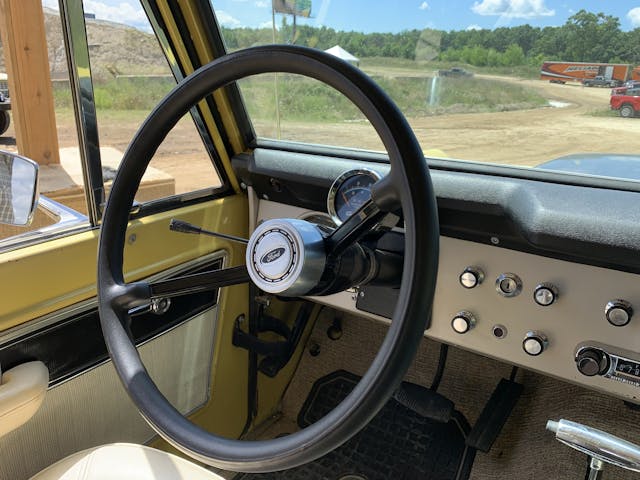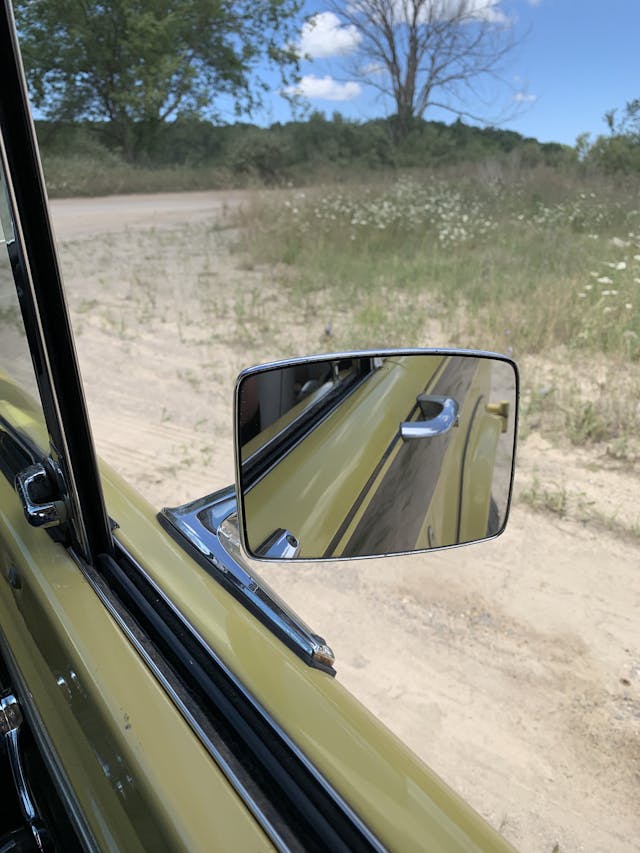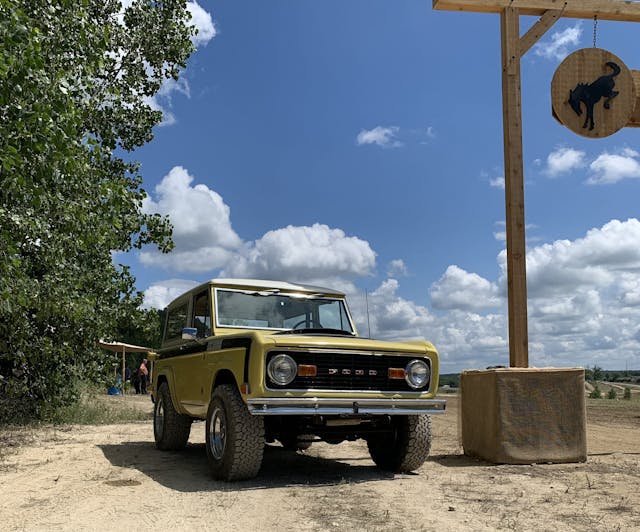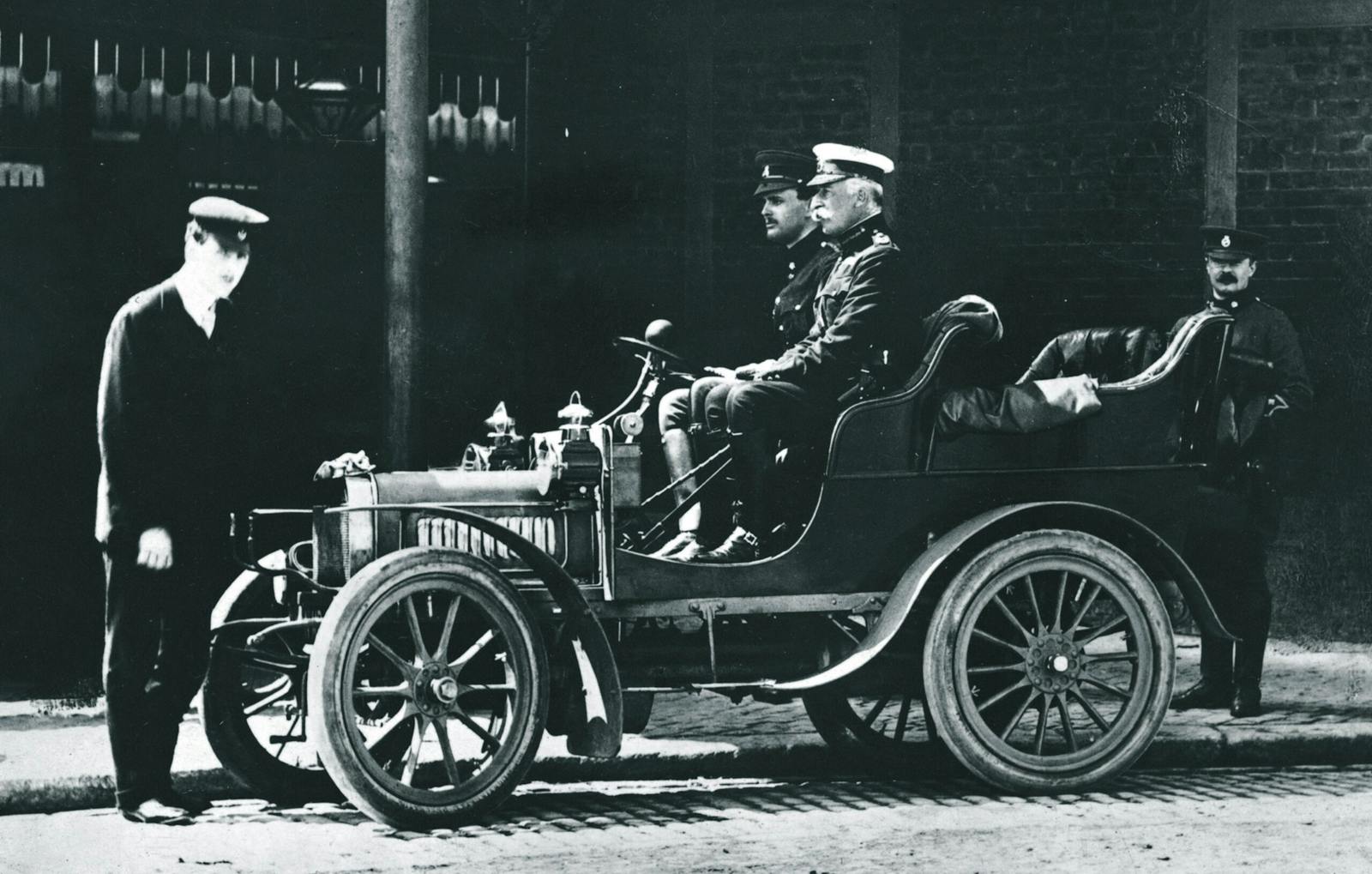Driving the 40-years-lost Boss Bronco prototype
Jolted to attention by the metallic slam of the Boss Bronco’s door, we settle onto the white vinyl seat and reach for the Mustang-sourced automatic shifter. There’s no need to turn the key, since the truck’s owner, Colin Comer, has done the tricky work of navigating the one-of-a-kind Bronco, its 351-cubic-inch V-8 rumbling deep in its throat, out of a Ford display tent crammed with display cases and structurally vital wood poles. Clear of obstacles, we swap seats.

We’re at Holly Oaks ORV Park in southeast Michigan to check out the 2020 Ford Bronco family, and though the facility—not yet open to the public—boasts 18- and 19-degree inclines worthy of the Bronco R race truck, there’s also a convenient, mildly graded loop that’s calling our name. Seems like a good option for a legendary prototype Bronco, which Ford invited to help highlight the off-road nameplate’s heritage.
“This one has hydraulically assisted brakes,” says Comer, anticipating the question as we prod the brake pedal with some trepidation. Right, then, no unassisted drums. With an easy tug of the shifter, we’re in drive. The Boss Bronco eases forward, and we hand-over-hand the wide steering wheel to the left, guiding the truck down a sandy path.
What exactly is the Boss Bronco? Think of it like a 1969 Bronco Sport that swallowed the mechanical guts of a contemporary Shelby GT350. Though the Boss was originally born on the Ford Assembly line, the real magic happened at Kar-Kraft, the Michigan race shop responsible for the Boss 429 Mustang and Ford’s Boss 302 race cars. Together with Bill Stroppe, the head of Ford’s off-road racing team, the engineering wizards at Kar-Kraft set about building a Bronco that was unmistakably in charge.
Stroppe and Kar-Kraft had a reputation for building machines that were every bit “go” as much as “show.” The Boss was no hollow promo piece for Ford; it was constructed as a proof-of-concept to convince Ford’s president at the time, Bunkie Knudsen, that a high-performance Bronco was both possible and worthwhile. Knudsen liked yellow, and rumor has it that the Boss Bronco’s Empire paint scheme catered to his specific taste.
The Boss Bronco is much more than an engine swap and a paint job, however. That 210-S-code 351-cubic-inch Windsor V-8 is mated to a C4 automatic transmission via a custom Kar-Kraft adapter (the conversion is implicit in the “210-S,” which designated a M-code 351 with a four-speed manual). Power reaches the wheels via a Ford 9-inch rear with a 4.11 ratio and a limited-slip differential. A Dana 30 axle sits up front, and Stroppe dual shocks sit on all four corners. Dirt-churning duty goes to 15 x 10-inch wheels clad with 10-15LT Gates Commando tires.
The Boss Bronco needed to announce its presence in more ways than one, of course, so designers installed Stroppe fender flares—for both form and function—and laid on black hockey-stick stripes. That four-barrel V-8 needed to breathe, so Kar-Kraft engineers went rummaging in Ford’s muscle car parts bin and emerged with a hood scoop from a Cougar Eliminator. The truck’s interior, wrapped in white vinyl, also received some extra aluminum bits and some black-and-white upholstered door panels.
The Boss Bronco was a smash hit, right? Unfortunately, we have no idea whether it won over Knudsen, because Lee Iacocca fired him before the fire-breathing truck could go from prototype to production. In fact, the Boss Bronco is lucky to have survived at all; when Kar-Kraft was liquidated in 1970, records show the yellow truck was destined for the crusher. The nature of its escape is shrouded in mystery, but the fact remains that, after disappearing for nearly 40 years, the Boss Bronco is alive and well and in the hands of an owner who lets it run free.
Though you’re likely more familiar with Hagerty marketplace expert Colin Comer for his Shelby expertise, he and his wife Cana also have a soft spot for Broncos. (You can hear them chat about their Bronco adventures in this livestream.) Comer came across the Boss Bronco through a friend, who had uncovered the prototype (by way of an expired eBay listing) residing in Washington State. Though Comer had to sell his Holman-Moody-built 1969 Bronco to make the purchase, it was worth the sacrifice.

The Boss Bronco isn’t some fantasy truck recreated from a surviving VIN plate and errant spark plug; aside from a repaint, Comer says the truck is largely untouched. It may show 60,000 miles on the odometer and have the paint chips to prove its 50+ years of use, but it’s the real deal, down to the original carburetor and prototype exhaust. The changes Comer did make were either in service of restoring the Boss Bronco to its rightful look or to help make it roadworthy. Today, the truck boasts resprayed side decals and a set of period-correct chrome wheels wearing new BF Goodrich 32-inch all-terrain tires.
The truck roars along at a sedate pace, windows down and a small trail of dust rising behind it. We crest a slight rise and hold the accelerator steady. The engine and the tires do the work, growling and churning through the sandy soil with little drama. Even with the summer air flowing through the cabin, the scent of old-truck mustiness lingers. Though the truck isn’t totally Spartan by 1969 standards—it has a radio and an automatic, after all—but the experience of driving it is no less immersive and raw. The roar of the engine, the dirt, the fresh air—it’s all there, unfiltered. The Stroppe rollcage arcs overhead, ensuring essential safety, but the slim doors, without the modern burdens of wiring, insulation, or even cupholders, feel skeletal and utilitarian by 2020 standards. The sound of the contemporary GT350 mill, even at low speed, permeates the cabin. That steady rumble, combined with the shallow dash and upright windshield, make you keenly aware there are but a few panels between your hands and the overhead-valve V-8. There’s a tachometer mounted on the steering column, but you rarely need it.

Comer’s been standing in a tent guarding his truck most of the day, so he hops behind the wheel to take a turn in the Boss. We’re immediately glad we buckled our seatbelt because Comer guns it, provoking a delicious V-8 bellow, a cloud of dust, and a sideways step from the unique-irreplaceable-very-expensive truck. (Better the owner goof off in it than us.) Obviously, the Boss doesn’t need to be babied. Though it’s here as a showpiece, this very special off-roader can still walk the walk.

In light of the new Bronco’s upcoming arrival to showrooms, and our ride-alongs in both the two-door and Bronco Sport variants that day, we can’t help daydreaming about the potential for this Boss Bronco theme writ for the modern age. Can’t you just imagine the GT350’s flat-plane-crank Voodoo V-8 in the 2021 Bronco? Ford, you’re welcome.
***
Check out the Hagerty Media homepage so you don’t miss a single story, or better yet, bookmark it. To get our best stories delivered right to your inbox, subscribe to our newsletters.





I like the original better. The new one is nice but old one has more character.
You guys really need to start having someone proof read these articles before they are posted. This one is particularly terrible for multiple reasons.